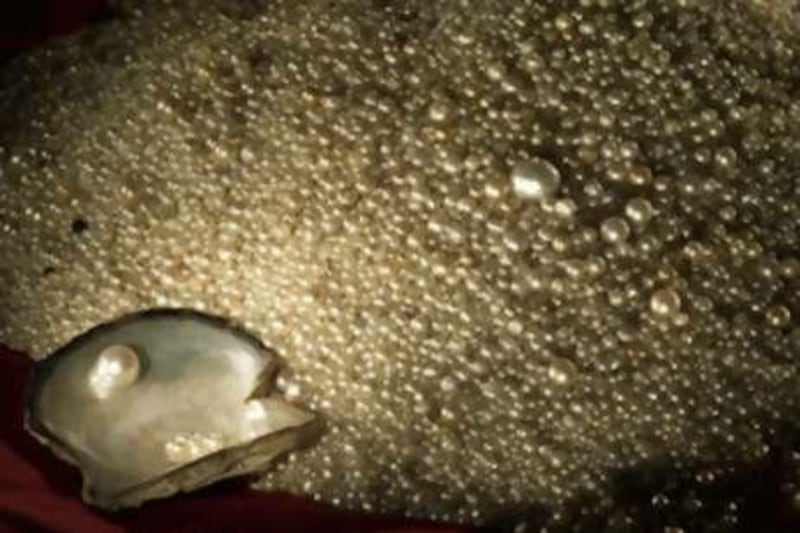There is an old Arabic legend that says a pearl forms when raindrops from a moonlit sky are swallowed by oysters beneath the sea. The ancient Egyptians prized the stone so much, in fact, that they were often buried with a person when they died. With such a deep-rooted history in this culture, it may come as a surprise that pearls until recently have held a very minor place in the region's jewellery industry. The markets of the Middle East, North Africa and South Asia (Menasa) have traditionally placed their focus on gold and diamonds, neglecting many other precious stones and gems. However, a combination of factors in recent years, including a shift in fashion preferences towards more classic designs and an expanding regional luxury market, has reignited an interest in the marketing and trading of pearls. "There were several factors that contributed to the decline of the industry overall," said Gaiti Rabbani, the executive director for the coloured stones and pearls division at the Dubai Multi Commodities Centre (DMCC), a strategic initiative of the Dubai Government. "One of the reasons that the industry actually died down here was overfishing and pollution of the waters. Also, availability of the stone has actually declined a bit in recent years." However, through initiatives laid out by the DMCC, Dubai's jewellery industry is looking to turn things around by positioning the emirate as the world's leading pearl trading hub. "Currently, there are industry bodies like the World Diamond Council, the World Gold Council, you have the International Coloured Gems Association, but you don't find something that represents the pearl industry," said Ms Rabbani. "It is a very fragmented industry because you've got different types of pearls developed in different markets." Last year, the DMCC launched the Dubai Pearl Exchange (DPE), an exclusive trading platform for the pearl industry. The exchange trades cultured and natural pearls through a members-only service. Recognising the importance of Dubai's pearling heritage and the new DPE, the Gemological Association of Great Britain (Gem-A) announced yesterday it was collaborating with the exchange to develop an education programme for natural pearls. The exchange will instruct the curriculum, with 15 subject areas, in Dubai and certificates will be presented by the DPE and Gem-A on completion of the short course of about four days. "The recent resurgence in the natural pearl market, coupled with Dubai's emergence as an international trading centre, offers enormous potential to re-establish Dubai's traditional link with pearling and thus benefit the emirate's tourist and jewellery trade," said Ahmed bin Sulayem, the executive chairman of the DMCC. Jewellery lovers, aspiring designers, gem traders, cultural tourists and Gulf nationals are among the groups being targeted by the DPE to learn about the beauty and history of natural pearls, and their fundamental place in the region's heritage. The DMCC is also teaming up with the Australia-based Arrow Pearls Company to launch an integrated pearl centre in Dubai to tap the global pearl industry, currently valued at US$1 billion (Dh3.67bn) per year and set to reach $3bn annually by 2010. The initiative is called "Pearls of Arabia" and will feature a high-quality offshore entertainment, retail and educational centre. In association with the original South Sea pearl company Paspaley Pearling, the DMCC will establish a 6,000 square metre "experience centre" at The World development. The destination will feature a pearl-themed cultural heritage centre, performing arts theatre, exhibition gallery and a themed restaurant alongside boutiques on the development's Antarctica group of islands. Industry insiders say the demand for a revival of the pearl industry has existed, but what was needed was a boost in resources similar to that being provided by the DMCC. "Globally, we've seen the demographic of customers start with gold, then diamonds, gem stones and then pearls but in terms of hierarchy, pearls are climbing back up in demand because of changing preferences, as well as for older customers who have other kinds of jewellery," said Amit Dhamani, the general manager of Dhamani Group, which is working with the DMCC on its pearl initiatives. "Ladies like to wear pearls because they know that each one is one of a kind." Whether natural or cultured, pearl cultivation has captured the interest of scientists and gem connoisseurs for centuries. At cultured pearl farms, particles are now implanted in oysters to encourage the formation of pearls and allow for more predictable production. Today's cultured pearl industry produces millions of high-quality pearls each year. DMCC officials highlight that their initiatives to boost the local pearl industry do not include pearl diving or cultivation. Ms Rabbani said that in such a highly competitive field as pearl cultivation, it was in Dubai's best interest to remain neutral, focusing on the trade, not the source. "People tend to think that we're getting into pearl cultivation and I've spent a lot of time explaining that we are not, and that helps in a way because we are trying to attract international producers to use Dubai as a trade hub, so we are neutral," she said. Pearls represent the broadest price spectrum of any type of jewellery, with stones ranging in price from $50 to $50,000. Gaetano Cavalieri, the president of the World Jewellery Confederation, said: "They retain the price, the value, and it is certainly a good investment." "By selling and producing this jewellery, we will showcase the old history of this region to the world," said Mr Dhamani. "I really believe this will have some great long-lasting effects." vsalama@thenational.ae
Simple pearls of wisdom
The emirate's jewellery industry is looking to position Dubai as the world's leading pearl-trading hub.

Editor's picks
More from the national




